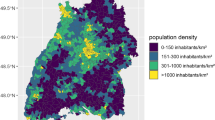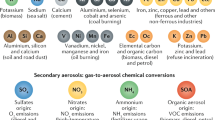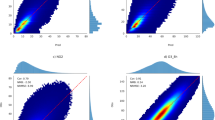Abstract
Many, but not all, observational epidemiological studies of ozone (O 3) air pollution have yielded significant associations between variations in daily ambient concentrations of this pollutant and a wide range of adverse health outcomes. We evaluate some past epidemiological studies that have assessed the short-term association of O 3 with mortality, and investigate one possible reason for variations in their O 3 effect estimate, i.e., differences in their approaches to the modeling of weather influences on mortality. For all of the total mortality–air pollution time-series studies considered, the combined analysis yielded a relative risk, RR=1.036 per 100-ppb increase in daily 1-h maximum O 3 (95% CI: 1.023–1.050). However, the subset of studies that specified the nonlinear nature of the temperature–mortality association yielded a combined estimate of RR=1.056 per 100 ppb (95% CI: 1.032–1.081). This indicates that past time-series studies using linear temperature–mortality specifications have underpredicted the premature mortality effects of O 3 air pollution. For Detroit, MI, an illustrative analysis of daily total mortality during 1985–1990 also indicated that the model weather specification choice can influence the O 3 health effects estimate. Results were intercompared for alternative weather specifications. Nonlinear specifications of temperature and relative humidity (RH) yielded lower intercorrelations with the O 3 coefficient, and larger O 3 RR estimates, than a base model employing a simple linear spline of hot and cold temperature. We conclude that, unlike for particulate matter (PM) mass, the mortality effect estimates derived by time-series analyses for O 3 can be sensitive to the way that weather is addressed in the model. The same may well also be true for other pollutants with largely temperature-dependent formation mechanisms, such as secondary aerosols. Generally, we find that the O 3–mortality effect estimate increases in size and statistical significance when the nonlinearity and the humidity interaction of the temperature–health effect association are incorporated into the model weather specification. We recommend that a minimization of the intercorrelations of model coefficients be considered (along with other critical factors such as goodness of fit, autocorrelation, and overdispersion) when specifying such a model, especially when individual coefficients are to be interpreted for risk estimation.
This is a preview of subscription content, access via your institution
Access options
Subscribe to this journal
Receive 6 print issues and online access
$259.00 per year
only $43.17 per issue
Buy this article
- Purchase on Springer Link
- Instant access to full article PDF
Prices may be subject to local taxes which are calculated during checkout




Similar content being viewed by others
References
Akaike H, A new look at statistical model identification, IEEE Trans Autom Control (1974) AU-19: 716–722
Anderson HR Ponce de Leon A Bland JM Bowers JS and Strachan DP, Air pollution and daily mortality in London: 1987–1992, Br Med J (1996) 312: 665–669
Borja-Aburto VH Loomis DP Bangdiwaia SI Shy CM and Rascon-Pacheco RA, Ozone, suspended particulates, and daily mortality in Mexico City, Am J Epidemiol (1997) 145: 258–268
Cakmak S, Burnett R, Krewski D, Adjusting for temporal variation in the analysis of parallel time series of health and environmental variables, J Exposure Anal Environ Epidemiol (Apr–Jun 1998) 8(2): 129–44
California Department of Public Health, Clean air for California: initial report of the Air Pollution Study Project. State of California, Department of Public Health, San Francisco, CA 1955
Caroll RJ Ruppert D and Stefanski LA, Measurement error in nonlinear models. Monographs on statistics and Applied Probability 63. Chapman & Hall, London 1995 p. 22
Cifuentes LA and Lave L, Association of daily mortality and air pollution in Philadelphia, 1983–1988, J Air Waste Manage Assoc (1997) Submitted for publication
Cleveland WS, Robust locally weighted regression and smoothing scatterplots, J Am Stat Assoc (1979) 74: 829–836
Dersimonian R, and Laird N, Meta-analysis in clinical trials, Control Clin Trials (1986) 7: 177–188
Ellis FP, Mortality from heat illness and heat-aggravated illness in the United States, Environ Res (1972) 5: 1–58
Hastie T, and Tibshirani R, Generalized additive models. Chapman & Hall, London, UK 1990
Hoek G Schwartz JD Groot B and Eilers P, Effects of ambient particulate matter and ozone on daily mortality in Rotterdam, The Netherlands, Arch Environ Health (1997) 52: 455–463
Ito K, Kinney P, and Thurston GD, Variations in PM10 concentrations within two metropolitan areas and their implications to health effects analyses, Inhalation Toxicol (1995) 7: 735–745
Ito K, Thurston G, Nadas A, and Lippman M, Monitor-to-monitor temporal correlation of air pollution and weather variables in the North-Central U.S, J Exposure Anal and Environ Epidemiol (2001) 11(1): 21–32
Kelsall JE Samet JM Zeger JE and Xu J, Air pollution and mortality in Philadelphia 1974–1988, Am J Epidemiol (1997) 146: 750–762
Kinney PL and Ozkaynak H, Associations of daily mortality and air pollution in Los Angeles County, Environ Res (1991) 54: 99–120
Kinney PL and Ozkaynak H, Associations between ozone and daily mortality in Los Angeles and New York City, Am Rev Respir Dis (1992) 145: A95(Abstract)
Kinney PL Ito K and Thurston GD, A sensitivity analysis of mortality/PM-10 associations in Los Angeles, Inhalation Toxicol (1995) 7: 59–69
Lipfert FW, Air pollution and community health: a critical review and data sourcebook. Van Nostrand Reinhold, New York, NY 1994
Mage DT and Buckley TJ, The relationship between personal exposures and ambient concentrations of particulate matter, Paper No. 95-MP18.01. Proceedings of the 88th Annual Meeting of the Air and Waste Management Association, Pittsburgh, PA (1995
Mage D, Wilson W, Hasselblad V, and Grant L, Assessment of human exposure to ambient particulate matter, J Air Waste Manage Assoc (1999) 49: 1280–1291
Moolgavkar SH Luebeck EG Hall TA and Anderson EL, Air pollution and daily mortality in Philadelphia, Epidemiology (1995) 6(5): 476–484
Ozkaynak H, Xue J, Severance P, Burnett R, and Raizenne M, Associations between daily mortality, ozone and particulate air pollution in Toronto, Canada, Paper presented at the Colloquium on Particulate Air Pollution, Irvine, CA, January 24–25, 1995
Ostro BD Sanchez JM Aranda C and Eskeland GS, Air pollution and mortality: results from a study of Santiago, Chile, J Exposure Anal Environ Epidemiol (1996) 6: 97–114
Pope CA III, and Kalkstein LS, Synoptic weather modeling and estimates of the exposure–response relationship between daily mortality and particulate air pollution, Environ Health Perspect (Apr 1996) 104(4): 414–420
Samet JM Zeger SL Kelsall JE Xu J and Kalkstein LS, Particulate air pollution and daily mortality: analysis of the effects of weather and multiple air pollutants, The Phase I.B Report of the Particle Epidemiology Evaluation Project. Health Effects Institute, Cambridge, MA March 1997
Samet J, Zeger S, Kelsall J, Xu J, and Kalkstein L, Does weather confound or modify the association of particulate air pollution with mortality? An analysis of the Philadelphia data, 1973–1980, Environ Res (1998 Apr) 77(1): 9–19
Schwartz J, Health effects of air pollution from traffic: ozone and particulate matter. In: Fletcher T., and McMichael A.J. (Eds.), Health at the Crossroads: Transport Policy and Urban HealthJohn Wiley & Sons Ltd. NY, NY 1997
Simpson RW Williams G Petroeschevsky A Morgan G and Rutherford S, The association between outdoor air pollution and daily mortality in Brisbane, Aust Arch Environ Health (1997) 52: 442–454
Snedecor GW and Cochran WG, Statistical Methods 7th edn. Iowa State University Press, Ames, IA 1980 pp. 343, 353
Thurston GD and Kinney PL, Air pollution epidemiology: considerations in time-series modelling, Inhalation Toxicol (1995) 7: 71–83
Touloumi G Katsouyanni K Zmirou D Schwartz J Spix C de Leon AP Tobias A Quennel P Rabczenko D Bacharova L Bisanti L Vonk JM and Ponka A, Short term effects of ambient oxidants exposure on mortality: a combined analysis within the APHEA project, Am J Epidemiol (1997) 146(2): 177–185
U.S. Bureau of the Census, County and City Data Book, 1983. U.S. Department of Commerce. U.S. Government Printing Office, Washington, DC 1983
U.S. Environmental Protection Agency (U.S. EPA), Air quality criteria for ozone and other photochemical oxidants. EPA Report No. EPA-600/P-93/004aF. Environmental Criteria and Assessment Office, Research Triangle Park, NC 1996 Apr 7–94
U.S. Environmental Protection Agency (U.S. EPA), Regulatory impact analysis for the particulate matter and ozone National Ambient Air Quality Standards and proposed regional haze rule. Appendix J. Table 3. Office of Air Quality Planning and Standards, Research Triangle Park, NC 1997
Verhoeff AP Hoek G Schwartz J and Wijnen JH, Air pollution and daily mortality in Amsterdam, Epidemiology (1996) 7: 225–230
Wechsler CJ Shields HC and Naik DV, Indoor ozone exposures, J Air Pollut Control Assoc (1989) 39: 1562
Acknowledgements
Funding for this study was provided by the National Institute of Environmental Health Sciences (NIEHS) under Grant ES05711. This study is also funded as a part of a Center Program supported by the NIEHS under Grant ES00260. The authors also thank Dr. Morton Lippmann for his comments on this paper.
Author information
Authors and Affiliations
Corresponding author
Rights and permissions
About this article
Cite this article
THURSTON, G., ITO, K. Epidemiological studies of acute ozone exposures and mortality. J Expo Sci Environ Epidemiol 11, 286–294 (2001). https://doi.org/10.1038/sj.jea.7500169
Received:
Published:
Issue Date:
DOI: https://doi.org/10.1038/sj.jea.7500169
Keywords
This article is cited by
-
Bayesian Bivariate Semiparametric Spatial Models for Ozone and PM2.5 Emissions
Environmental Modeling & Assessment (2021)
-
Short-term effects of meteorological factors, air pollution, and sunspot on childhood hand, foot, and mouth disease in Tianjin, China: a new time series regression, 2014–2018
Environmental Science and Pollution Research (2020)
-
Climate change impacts on projections of excess mortality at 2030 using spatially varying ozone–temperature risk surfaces
Journal of Exposure Science & Environmental Epidemiology (2017)
-
Searching for the best modeling specification for assessing the effects of temperature and humidity on health: a time series analysis in three European cities
International Journal of Biometeorology (2015)
-
Short-term effects of multiple ozone metrics on daily mortality in a megacity of China
Environmental Science and Pollution Research (2015)



